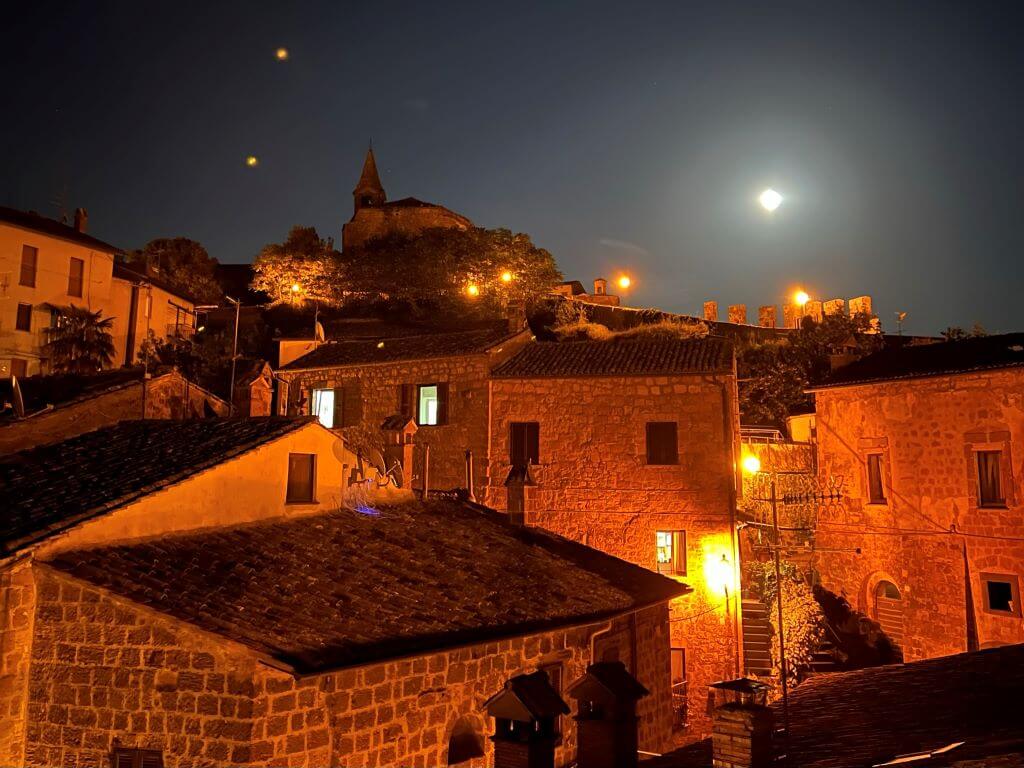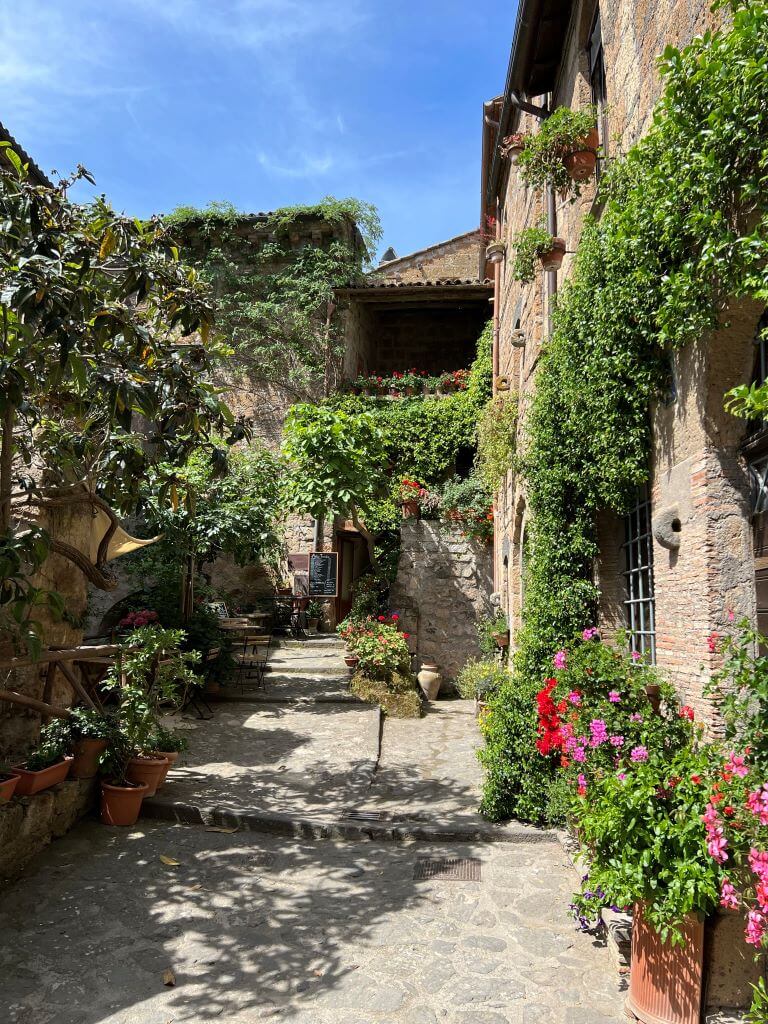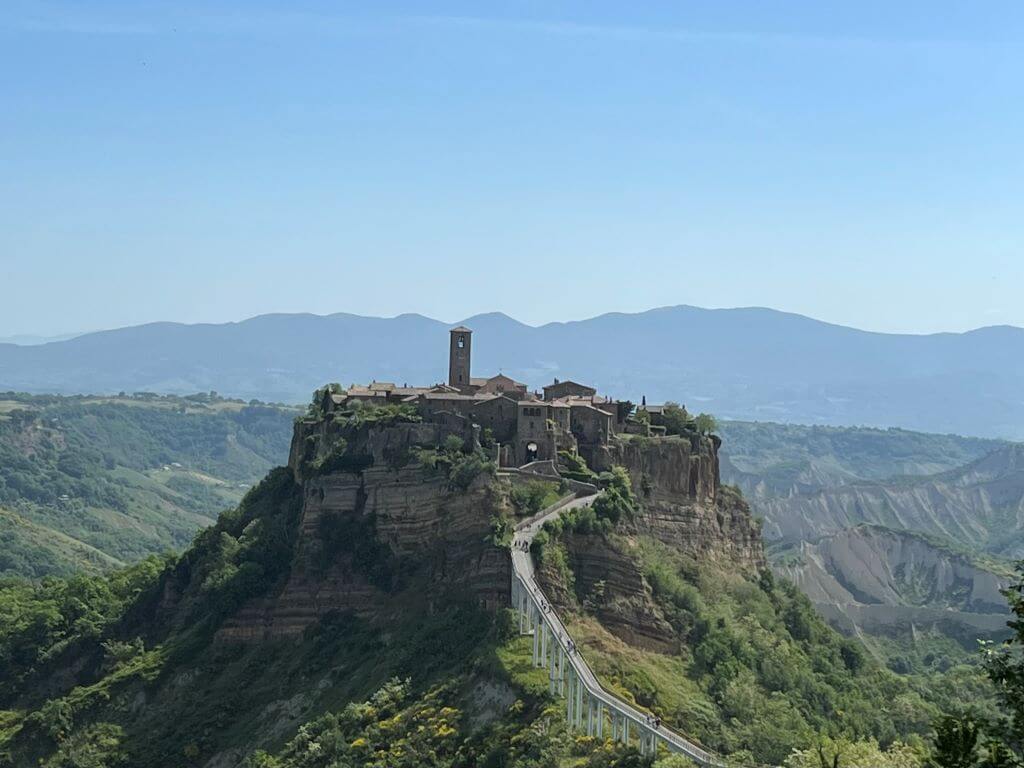Orvieto: One of Italy’s Most Charming Hilltop Towns

Orvieto in Italy’s Umbria region is frequently ranked as one of the country’s top hilltop towns. After my lovely but far-too-short visit there in May 2022, I can attest that it more than deserves these accolades!
With the exception of its wonderful duomo, Orvieto doesn’t have any must-see tourist attractions, but it’s partly for that reason that Orvieto is so special. It invites you to slow down for a bit while you take in its medieval ambience and charming streets.
But that doesn’t mean there aren’t still plenty of things to do! Orvieto has its duomo, the MoDo City Museum and an assortment of other smaller attractions worth seeing to fill up your time. The fairy tale hilltop town of Civita di Bagnoregio is also just a short drive away.
So, grab a vino and keep reading to see what awaits you in the town of Orvieto!
Disclaimer: This post may contain affiliate links. If you make a purchase through one of these links, I will earn a small commission. This occurs at no added cost to you.
Civita di Bagnoregio
| Hours | Town is always open |
| Length of Visit | 5 – 10 minutes for viewpoint 60 – 90 minutes if going into town |
| Cost | €5 |
| Highlights | Great views of town, beautifully manicured gardens |
You’ve probably seen Civita di Bagnoregio on social media. It’s the small walled medieval town perched precariously atop a hill in the middle of a forested canyon. Civita di Bagnoregio looks more like a scene from an artist’s brush than an actual town.
A visit here is a must for many, but is it actually worth driving the 30 minutes from Orvieto?
At the very least, you should drive to the viewpoint for the view. It truly is stunning and one of the best in Italy, even if you have to go out of your way a bit to see it.
However, whether or not you should walk into Civita di Bagnoregio is a different matter.
The inside of this tiny hilltop town is adorable in the way that most hilltop towns are, perhaps even more so because of its more intimate size. It feels touristy, though, and not just because of all the tourists – of which there were many during our visit.
Civita di Bagnoregio has a population in the double digits. Because of this fact and how perfectly manicured some of it feels (there are some gorgeous flower arrangements set against the town’s dusty architecture), it felt a bit like the Disney version of a hilltop town compared to places like Volterra and Siena.
So, my recommendation is to drive in to see the viewpoint. If the bridge doesn’t seem too crowded and you have an hour to spare, head into Civita di Bagnoregio. Otherwise, Orvieto will more than satisfy your hilltop town itch!


Try to visit on a weekday early or later in the day to avoid crowds if you’re intent on visiting.
Duomo of Orvieto
| Hours | November – February Daily 9:30 – 5:00 March and October Daily 9:30 – 6:00 April – September Daily 9:30 – 7:00 Reduced hours on SundaysNovember – February Daily 9:30 – 5:00 March and October Daily 9:30 – 6:00 April – September Daily 9:30 – 7:00 Reduced hours on Sundays |
| Length of Visit | 20 – 30 minutes |
| Cost | €5 (includes MoDo City Museum) |
| Highlights | Exterior facade, San Brizio Chapel |
Orvieto’s duomo was possibly my favorite of the many churches and cathedrals we visited during our 17-day tour of Italy. It has a grand facade and some stellar Renaissance frescoes that help it to stand apart from other cathedrals we saw.
Before you enter, take in the exquisite facade. The reliefs on each of the four pillars tell the story of the world from the Creation to the Last Judgment. Above these reliefs are gold-backed frescoes depicting various biblical scenes and characters.
Once inside, the San Brizio Chapel in the right transept is one of Italy’s top Renaissance highlights. This stunning series of frescoes takes up each upper wall of the small chapel and tells the story of the end of days (much of it is actually symbolic of political turmoil in Italy at the time). Most of the frescoes were done by Luca Signorelli from 1499 to 1504, but the chapel has some parts done by Fra Angelico 50 years earlier.
Don’t rush your time in San Brizio Chapel! The frescoes are sweeping in their scale, but they have lots of small details that make them special.



Tuscany is home to another of Italy’s most famous duomos. You can read more about it with my guide to Florence’s Piazza del Duomo.
Nighttime at the Duomo
Don’t forget to head over to Piazza del Duomo before calling it a night. Orvieto’s duomo was my favorite singular floodlit architectural marvel during my time in Italy.
On top of the hill, with all other lights turned down low, the duomo’s facade practically glows into existence against the black sky behind it. The floodlights against the cathedral make the frescoes and reliefs much more vivid than they are in daylight.
Between that and the lack of other tourists, it’s a great opportunity to admire the detail of all the art while having a moment of solitude.

Cathedral Arts Collection
| Hours | November – February 9:30 – 5:00, closed Mondays March and October Daily 9:30 – 6:00 April – September Daily 9:30 – 7:00 |
| Length of Visit | 30 minutes |
| Cost | €5 (includes duomo) |
| Highlights | St Michael and dragon statue, Madonna and Child statue, original construction materials |
Just behind the duomo is the Cathedral Arts Collection housed in the Palazzi Papali. This small art museum doesn’t have any real highlights, but its intimate setting makes for a nice detour from the crowds and heat.
While there are no highlights, that doesn’t mean that there is nothing of interest. It still has some nice statues, paintings and various other objects on display that merit your attention. In particular, I enjoyed the statues of the Madonna and Child and of St Michael standing on a dragon.
The collection also houses some original equipment used in the construction of the duomo in its bottom level.


MoDo City Museum
The Cathedral Arts Collection is one of three attractions that make up the MoDo City Museum. You may also see the museum referred to by its full name, the Museo dell’Opera del Duomo.
The two other sights you can see as part of the MoDo City Museum include the Emilio Greco Collection and the Church of Sant’Agostino. You only need to purchase one ticket for these three attractions and the duomo.
St Patrick’s Well
| Hours | May – August Daily 9:00 – 8:00 March – April, September – October Daily 9:00 – 6:45 January – February, November – December Daily 10:00 – 4:45 |
| Length of Visit | 15 – 30 minutes |
| Cost | €5 |
| Highlights | Unique experience of being in a well, photogenic views |
How often do you get a chance to walk down a deep, dank well? Well, here’s your opportunity!
St Patrick’s Well is a 175-foot deep well that tourists can descend into for a unique experience. You’ll climb down and back up 248 slick and uneven stairs. There are windows spaced evenly along the way to lean out for a glance in either direction if you’re brave enough. At the bottom of the well is a small walkway where water has pooled underneath your feet. From here, there’s a haunting view back up the well to its opening above your head.
The well was built in the mid-16th century at the request of the pope who was using Orvieto as a safe haven during an attack on Rome. Fearful that Orvieto could be besieged and with no reliable water source on top of the hill, the pope had the well built to supply water to the town.
St Patrick’s Well is also notable for its two staircases arranged in a double spiral pattern. This arrangement created a one-way system of traffic. Townsfolk and their donkeys could go into the well for water and come back up without running into anyone.

The well is a bit pricey for such a quick visit, but I think it’s worth it because of how unusual of an attraction it is. It is also very photogenic for the amateur photographers out there.
Explore Orvieto’s Medieval Streets
Besides the duomo, Orvieto doesn’t have any particular significant highlights. Sure, it has the art museum and well I mentioned above and a few other attractions I’ll talk about below, but there isn’t anything you have to do.
Rather, the reason for visiting Orvieto is to just relax and take your time wandering its romantic medieval streets. I encourage you to just get lost amid its small squares and back roads, but here are a couple walking routes I recommend.
These walks were great, but they weren’t quite my favorite in Italy. For that, it has to be my walk through Venice bright and early in the morning before anyone else was awake!
Corso Camillo Benso di Cavour
Corso Camillo Benso di Cavour is one of the main thoroughfares through Orvieto. It’s lined with a variety of small shops, cafes, gelaterias and hotels that make it nice for doing a bit of browsing. More importantly, it has lots of cute pedestrian roads intersecting it that warrant poking your head down for a quick look.


This walk can conveniently be done either to or from St Patrick’s Well. However, it is a bit of a long walk, especially in the heat of day. If possible, I recommend walking either direction and taking the city bus in the other.
Head West at Twilight
This short but picturesque walk was filled one with one romantic scene after another. The route takes you on Via Filippeschi through Piazza della Repubblica and then Via Della Cava as you approach the western edge of town.
As you walk through this part of town, you’ll feel like you are being transported back to old-world Italy. There are many small winding streets leading away from the main thoroughfare that beg to be explored, and the walk is capped by a breathtaking view of Orvieto’s rooftops with a stark church atop a hill in the distance. It’s all illuminated by a soft orange glow from the streetlights reflecting off the rock used to build Orvieto’s streets and buildings.
Of the things we did in Orvieto, this walk is the one that made me regret that we didn’t have more time here!


Other Things to do in Orvieto
Orvieto was the only town where I felt like we didn’t have enough time. We easily could have spent another day here exploring its delightful roads and some of its other tourist attractions.
Below are a few of things of the things I would have liked to do with a bit more time.
National Archaeological Museum of Orvieto
The National Archaeological Museum of Orvieto is a small museum behind the duomo with several rooms of Etruscan artifacts discovered near the city.
The highlight of the museum is the Golini tombs. These reconstructed tombs feature original frescoes depicting an Etruscan banquet.
Well of the Quarry
If you enjoyed St Patrick’s Well, you might enjoy the Well of the Quarry, too. This privately owned attraction takes you under the city to explore a series of Etruscan-era tunnels and rooms carved into the cliff.
Etruscan Necropolis
The Etruscan Necropolis is a grouping of Etruscan tombs from the 6th to 3rd centuries B.C. For a small fee, you can walk along the streets that create a grid network through the necropolis.
The tombs are unadorned, as any decoration or artifact has long since been removed to Orvieto’s various museums. Rather, the appeal of a visit is more so to experience the atmosphere of walking through this Etruscan city of the dead.
The Etruscan Necropolis is found at the base of the cliff that Orvieto sits upon. You can see the necropolis from the Rupe if you don’t want to make the trip but still want to see this ancient cemetery.
Walks on the Rupe
Encircling Orvieto on the cliffside just below town, the Rupe is a nice spot to get away from the crowds for some exercise and fine views of the Umbrian countryside.
The Rupe has five different access points from town, and it has a total distance of 3 miles. Make sure you wear comfortable shoes as some sections are steep or on loose terrain.
Where to Stay in Orvieto
We stayed in B&B La Magnolia during our brief time in Orvieto. La Magnolia has a combination of smaller rooms and apartments. The apartments are a little larger with a living area and kitchenette included. We were upgraded to an apartment for our stay. While we didn’t use the kitchenette, I would recommend one of these units if you have a longer time in Orvieto and want to prepare meals.
The hotel has a lot of nice decorative touches to make it feel like a cozy place to stay, but the highlight is its location. It’s just a 3-minute walk from the hotel’s door to the duomo!
You can even see the duomo over La Magnolia’s terra cotta roof by climbing the hotel’s many steps to the top unit for a nice photo op. If you’re lucky, you might see the resident cat seeking refuge up there, too!
La Magnolia has a breakfast included in your rate. Unfortunately, we had to leave Orvieto early the next morning to catch a train to Pompei, so I can’t speak to its quality.


Where to Eat in Orvieto
Il Malandrino Bistrot
We stumbled upon il Malandarino Bistrot by mere convenience more than anything else. It was near where we needed to be, and it looked cute. With our two boxes checked, we sat down in their delightful outdoor patio for lunch.
Unfortunately, I can’t tell you what we had because I didn’t write it down or take any photos, but both of our pasta dishes were quite good and cost effective for a cafe we just picked at random.
Right up the road from il Malandrino is a convenient laundromat. You can grab a delicious meal and some cheap Orvieto wine while you wait for your clothes to be done.
Trattoria la Grotta
Trattoria la Grotta was recommended to us by the owner of B&B La Magnolia. It did not disappoint! We had many great meals in Italy, and this was one of the best.
Trattoria la Grotta is one of those excellent restaurants in Italy that make you feel more connected with the country than any tourist attraction possibly can. It has masterfully crafted regional food and wine, and it’s all served in a lovingly designed space that feels both rustic and modern at the same time.
For our meal, we had guinea fowl, tagliolini with duck ragu and pappardelle with wild boar. Every single bite was perfect! It was also shockingly inexpensive considering the quality of everything we had.
Getting to Orvieto
Getting up to and back out of Orvieto can be a bit of a process. Drivers can park below the cliff by the train station for free and then take the nearby funicular into the old town center. For those arriving by train, you would also take the funicular. The other option for drivers is a pay parking lot on the other side of the cliff with elevators to take you to town. Orvieto also has parking in town if you’re comfortable driving through Italy’s narrow city streets.
If you take the funicular into town, Orvieto has a bus that is timed with the funicular’s arrival to shuttle tourists to the duomo. Your funicular ticket covers the shuttle fare.
Keep in mind the funicular only runs from 7:15 to 8:30. If you are arriving outside of those hours, there is a bus you can take to get into or out of Orvieto.
More Resources for Planning Your Trip to Italy
Here are some of the other itineraries I’ve written to help you plan your dream trip to Italy!
And don’t forget to check out some of my tips and thoughts when it comes to planning a trip to Italy.
Resources to Book Your Trip to Orvieto
Whether you’re looking for tours, hotels or flights, here are some tools to help get you started planning your trip to Orvieto!
Look for activities and tours offered through GetYourGuide or Viator!
Search Flights
Still can’t find what you’re looking for? Check out my travel essentials pages for more of my recommendations.
Pin This Post!






12 Comments
Laura
Hi Paul, great summary of this area, just like your other posts! I love the photos of the small streets. It’s amazing how different lighting changes the ambiance. The Civita di Bagnoregio looks lovely. A great place to wander.
paulpassingthrough
I found that to especially be true in Italy where you had old buildings made with the rock they have. They just capture the moonlight and streetlights so well. They practically glow!
Barry Till
I have not seen a painted fresco on a Cathedral like the one in Orvieto, It is superb and so colourdul. The inside frescos would have me staring at them for hours. Such detail and intricacy that I would want to understand every one of those scenes.
I know of Orvieto only by its famous wine – it was my favourite wine in my earlier days and it still brings back the memories with just one sip.
Those pedestrianised streets look so well maintained and atmospheric, especially from thos nightime pics you took.
Clearly there s a lot more to Orvieto than its wine …. and the accomodation and eatery tips are so helpful too.
paulpassingthrough
The wine is pretty good, too! You’re absolutely spot on about the frescoes in the duomo. The one I detailed was just so captivating. I definitely looked it for way longer than my wife liked haha
Peggy Zipperer
I have a fascination with the hilltop towns so I love this post. For you to say Orvieto’s duomo was your favorite singular floodlit architectural marvel is really saying something! And St. Patrick’s Welll looks fascinating. Marking this on my list for the next trip to Italy!
paulpassingthrough
Maybe some of it was the wine, but sitting outside of the duomo at night by myself was a great experience. Just staring up at the artwork on its facade and imagining the millions of people over the years who have done the same thing.
Lyn (aka Jazz)
wow, I really missed a spectacular town. It is going on the list for my next Italian trip (and there is always a next Italian trip!). I am especially fascinated with Civita di Bagnoregio, which I learned about from your post.
Happy Travels!
paulpassingthrough
I’m always dreaming about my next trip to Italy! I hope you enjoy Orvieto as much as I did. I’d love to get back there and just really take my time over the course of a couple days.
Molly | Transatlantic Notes
And now I need a vacation in a hilltop town, haha! This was lovely to read, especially as it’s within an area of the world I particulalry love and have fond memories of visting when I was teenager. Lovely post!
paulpassingthrough
So much to love here. Did you ever visit Orvieto? I really want to go back myself to take it in over the course of a couple days.
Nick
So great, love these small Italian places. Great way to unwind and enjoy local life.
paulpassingthrough
So much history and they’re all so proud in their towns. It shows in how pretty they all are.